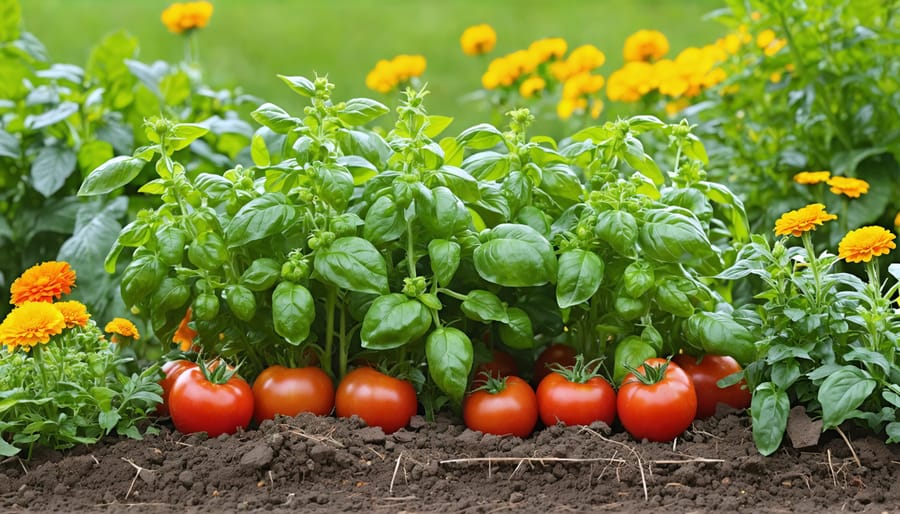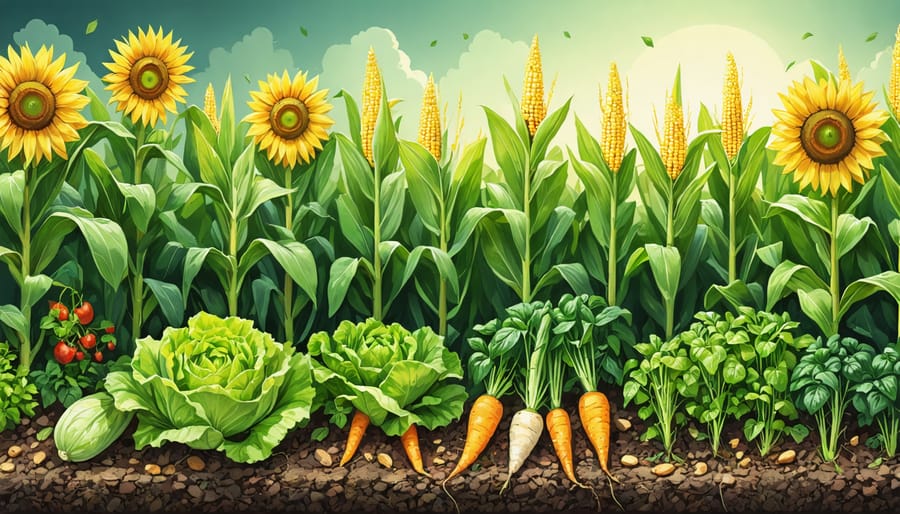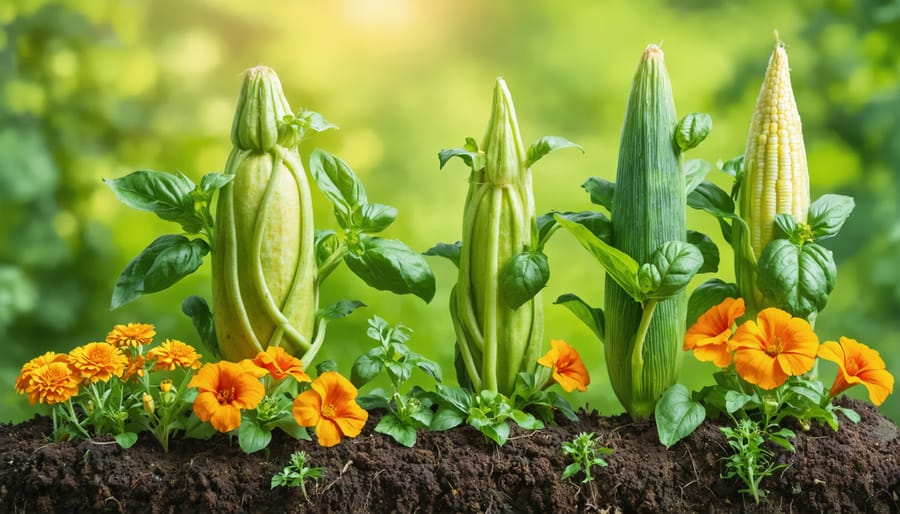Transform your garden’s productivity with space-saving companion planting by growing these three perfect plant partners: basil, tomatoes, and marigolds. This classic trio creates a symbiotic relationship where basil enhances tomato flavor while repelling pests, marigolds ward off harmful nematodes, and tomatoes provide natural shade protection. Plant these companions 18 inches apart in well-draining soil, and watch as they work together to create a thriving mini-ecosystem that maximizes your growing space. Whether you’re tending a small balcony garden or a raised bed, this combination delivers a bountiful harvest while naturally protecting each plant from common garden challenges. The best part? You’ll harvest fresh ingredients for countless Mediterranean dishes throughout the growing season, making this trio as practical as it is beautiful.
The Three Sisters Garden: A Time-Tested Trio
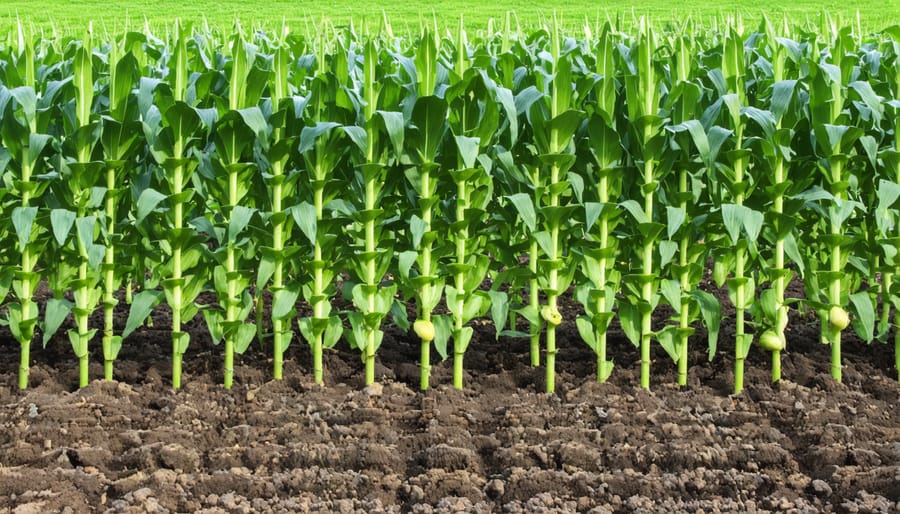
How They Support Each Other
The magic of this trio lies in how perfectly they complement each other. Tall, sturdy corn stalks act as natural trellises for the climbing bean vines, eliminating the need for artificial supports. As the beans grow upward, they spiral around the corn, creating a strong living structure that helps both plants stand tall even in windy conditions.
But the benefits go deeper than just physical support. Bean plants are nitrogen-fixing champions, enriching the soil by converting atmospheric nitrogen into a form that all three plants can use. This natural fertilization process is particularly beneficial for corn, which is a heavy nitrogen feeder. The beans essentially feed their companions while feeding themselves!
Meanwhile, squash plants spread their large leaves across the ground, creating a living mulch that helps retain soil moisture and suppress weed growth. Their prickly leaves also deter many garden pests, including raccoons that might be tempted by ripening corn. The shade provided by the squash leaves keeps the soil cool and reduces water evaporation, benefiting the shallow roots of all three plants.
Planting and Spacing Tips
When planting your trio of companion plants, proper spacing is crucial for their mutual success. Start by selecting a sunny spot in your garden with well-draining soil. For traditional Three Sisters garden spacing, create mounds about 4 feet apart, with each mound approximately 18 inches high and 4 feet wide.
Plant your tallest plant (like corn or sunflowers) in the center of each mound, spacing them 6-8 inches apart. Once these reach about 6 inches tall, plant your climbing varieties (such as pole beans or peas) in a circle around them, keeping 4-6 inches between each plant. Finally, add your ground-covering plants (like squash or herbs) around the outer edge, spacing them 12-18 inches apart.
For container gardens, choose a pot at least 24 inches deep and 20 inches wide. Place your tall plant slightly off-center toward the back, climbing plants 4 inches away from the center, and trailing plants near the pot’s edge. Remember to leave enough room for each plant to reach maturity without overcrowding its companions.
Tomato, Basil, and Marigold Partnership
Benefits and Growth Patterns
When planted together, these three companions create a harmonious growing environment that benefits each plant in unique ways. The tall, sturdy corn stalks act as natural supports for climbing beans, eliminating the need for separate trellises. Meanwhile, the beans perform double duty by fixing nitrogen in the soil, enriching it for all three plants, while their natural pest-repelling properties help protect the entire group.
The low-growing squash spreads along the ground, creating a living mulch that helps retain soil moisture and suppress weed growth. Its broad leaves provide shade for the soil and corn roots, while also deterring pests like raccoons who don’t like walking on the prickly vines.
These plants grow at different heights, creating a vertical garden that maximizes space efficiency. The corn reaches skyward, beans climb up the middle, and squash sprawls below, ensuring each plant gets adequate sunlight without competing for space. This arrangement also promotes better air circulation, reducing the risk of fungal diseases and creating a healthier growing environment for all three plants.
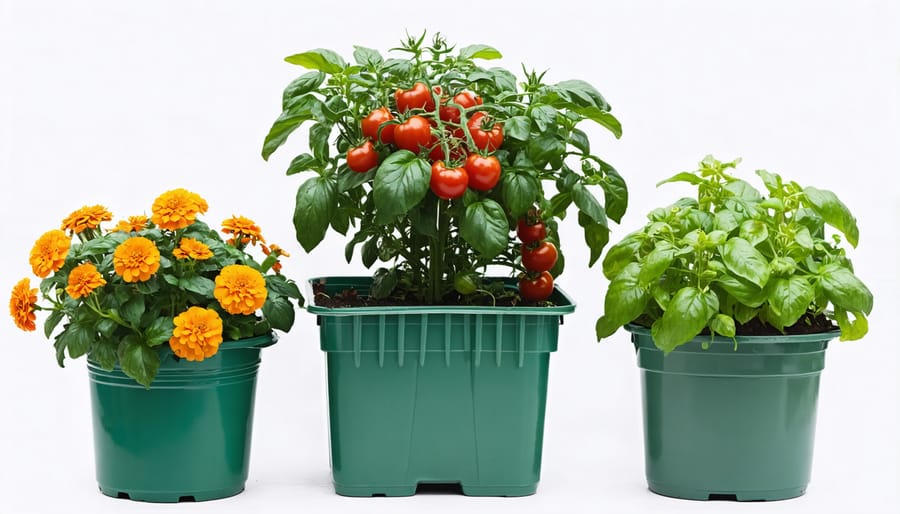
Container Garden Setup
Setting up your container garden for companion planting is easier than you might think. Start with a container that’s at least 18 inches deep and 24 inches wide to give your plants adequate room to grow. Make sure your pot has drainage holes – this is crucial for preventing root rot.
Fill your container with high-quality potting mix, leaving about 2 inches of space at the top. Mix in a slow-release organic fertilizer to provide steady nutrition throughout the growing season. Position your container where it will receive at least 6 hours of sunlight daily.
When planting, place the tallest plant toward the back or center of the container. Space your plants slightly closer together than you would in a traditional garden, but be careful not to overcrowd them. Leave about 6-8 inches between plants to allow for proper growth.
Create a simple watering schedule, checking soil moisture daily by inserting your finger about an inch deep. Water thoroughly when the soil feels dry at this depth. Consider adding a layer of mulch around your plants to help retain moisture and suppress weeds.
For best results, monitor your container garden regularly and adjust care as needed based on weather conditions and plant growth.
Caring for Your Companion Garden
Maintaining your companion garden doesn’t have to be complicated. In fact, these plant combinations are designed to make your gardening life easier, but a little care goes a long way in ensuring their success.
Start by monitoring soil moisture levels regularly. While companion plants often help each other thrive, they still need consistent watering. Water deeply at the base of the plants rather than spraying from above to prevent fungal issues. A layer of organic mulch around your plants will help retain moisture and suppress weeds.
Keep an eye on plant spacing as your companions grow. Even though these plants are friendly neighbors, they need room to breathe. If you notice overcrowding, don’t hesitate to trim back more vigorous plants to give their companions space. This is especially important for climbing plants – guide them onto their supports early to prevent them from overwhelming their companions.
Watch for signs of pest problems, but don’t panic at the first sight of an insect. Many companion plantings naturally deter pests, and some beneficial insects are actually helping your garden thrive. If you spot harmful pests, try removing them by hand first before considering organic pest control methods.
Fertilizing your companion garden requires a balanced approach. Most companions will thrive with a light application of compost tea or organic fertilizer every few weeks during the growing season. However, avoid over-fertilizing, as this can lead to excessive foliage growth at the expense of flowers or fruits.
Common challenges you might encounter include:
– Uneven growth rates: Some plants may grow faster than others. Regular pruning helps maintain balance.
– Competition for nutrients: Add compost to your soil regularly to ensure adequate nutrients for all plants.
– Seasonal transitions: As one plant completes its lifecycle, have seedlings ready to fill gaps.
Remember to harvest regularly from edible companions – this encourages continued production and prevents plants from becoming overgrown. At the end of the growing season, make notes about what worked well and what you might want to adjust next year. Successful companion gardening is often about learning from experience and making small improvements each season.
Growing plants together isn’t just about saving space – it’s about creating thriving garden partnerships that benefit each other and your garden as a whole. These companion planting combinations offer natural pest control, improved pollination, and better use of nutrients in your soil. By growing these plants together, you’ll not only maximize your garden space but also create a more sustainable and productive growing environment.
Whether you’re working with a small balcony garden or a larger plot, these plant combinations are perfect for getting started with companion planting. Give them a try this growing season, and you’ll likely notice healthier plants, better yields, and fewer pest problems. Remember to observe how your plants interact and adjust your combinations based on what works best in your unique garden space. Happy planting!

